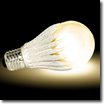
By Bob Crane
July 30, 2009
The latest white LED light bulbs are in some ways the first magical, energy-saving device that is easy to install for anyone. As with any new technology, getting the most out of LED light bulbs requires some thought and planning on how, when and where to use them.
Can you really save 90% of your lighting costs with a new LED bulb?
 The answer is a qualified “yes” and here is what you need to know. The technology used in the highest-quality bulbs is expensive so the capital costs are high. Commercial applications, like in a hotel lobby, are a good use to consider. In addition to saving close to 90% of the electrical energy used be a comparable incandescent bulb, LED bulbs also last 30 times longer. This saves labor costs associated with changing burnt-out bulbs and safety. The safety factor for employees is important to consider since falling is a leading cause of injury and death in the United States.
The answer is a qualified “yes” and here is what you need to know. The technology used in the highest-quality bulbs is expensive so the capital costs are high. Commercial applications, like in a hotel lobby, are a good use to consider. In addition to saving close to 90% of the electrical energy used be a comparable incandescent bulb, LED bulbs also last 30 times longer. This saves labor costs associated with changing burnt-out bulbs and safety. The safety factor for employees is important to consider since falling is a leading cause of injury and death in the United States.
White LEDs use 40%-50% less energy than Compact Fluorescent bulbs. Because of the high cost of LEDs, CFLs are still a better financial investment in most cases. That said, CFLs do have problems with premature burnout, slow warmup time, shape, color change over the life of the bulb, mercury and significant light depreciation over its lifespan. LED bulbs do not have any of these shortcomings, as they reach full brightness instantly, retain their color and brightness longer than CFLs, and do not contain any mercury.
What about the color of the light?

|
Standard colors are Warm, Soft and Cool. Cool White bulbs put out the most light per watt while Warm White bulbs put out the least amount of light per watt. Special High Color Rendition bulbs are available but are very expensive. Trying the colors out in an application will help you make a decision.
What is the best application?
Since LED bulbs cast their light primarily in one direction, White LED bulbs are best used in a ceiling or open track-lighting type fixture. Incandescent bulbs direct half of their light toward the socket, in effect generating unusable or wasted light. Wasted light means inefficient use of electricity and money.
What is my Return On Investment?
If you are replacing incandescent bulbs, then your ROI, just in terms of energy use and not counting maintenance savings, can approach three years where electricity rates are high. Granted, the cost of electricity varies widely but businesses in large cities typically pay the highest rates, which can be 15 cents a kilowatt hour or higher. An energy specialist can make a detailed plan before you make a financial commitment.
As with any new technological advance, there will be many new LED light bulb companies rushing to get an array of new products to market. Many performance claims will be made and many may not be true. The actual LED’s themselves are made by several manufacturers. Only a few companies have the highest quality so it is best to find out what type of LED is used in the bulb you are considering. Since high quality LEDs last 30,000 hours or more the other components in the circuit have to be able to last as long as the LEDs. All long-life LED light bulb manufacturers should be able to provide you with aging reports. Manufacturers should also be able to tell you the efficiency of the circuit or, in other words, the “power factor” of their LED light bulbs.
Here are some points to check out with any manufacturer:
1. How long has the company been in business?
2. Is the warranty clear? This is a measure of the company’s faith in the product.
3. Do they have independent lab reports to back up their performance claims?
4. Are they UL-listed and FCC approved?
5. How long have they been in production?
There is no easier way to save energy than to change a light bulb. The technology used in LED light bulbs continues to improve and go down in price, which means that the costs of the LED light bulbs will also decrease in due course. If you are already prepared to invest in LED light bulbs, keep in mind that the distribution network for this high-growth market is still under development so you may want to consider going directly to the manufacturer and asking for a high-volume discount. Just don’t wait too long before switching over to LEDs, after all, we only have about 200 years of coal left to burn for our energy needs, and our current lighting practices waste far too much energy.
Bob Crane is president of C. Crane Company, Inc, an innovator in the
electronics industry and design. A forerunner in LED lighting sales and
technology, they began their research and development of multiple white LED flashlights in 1997.








